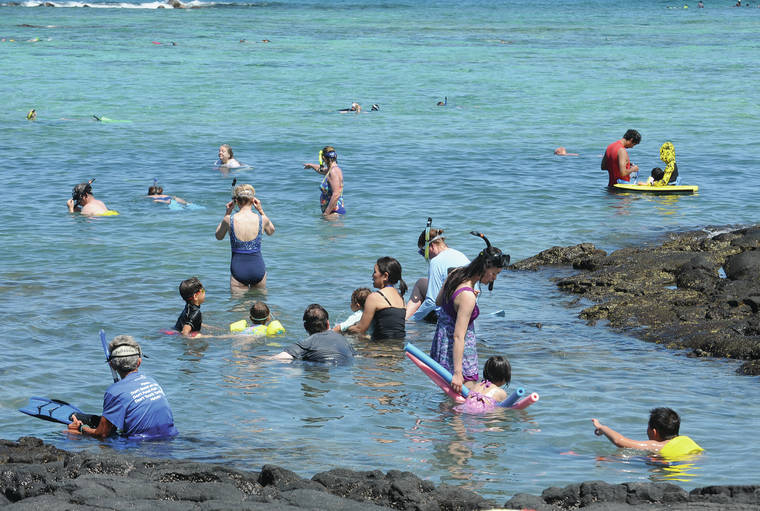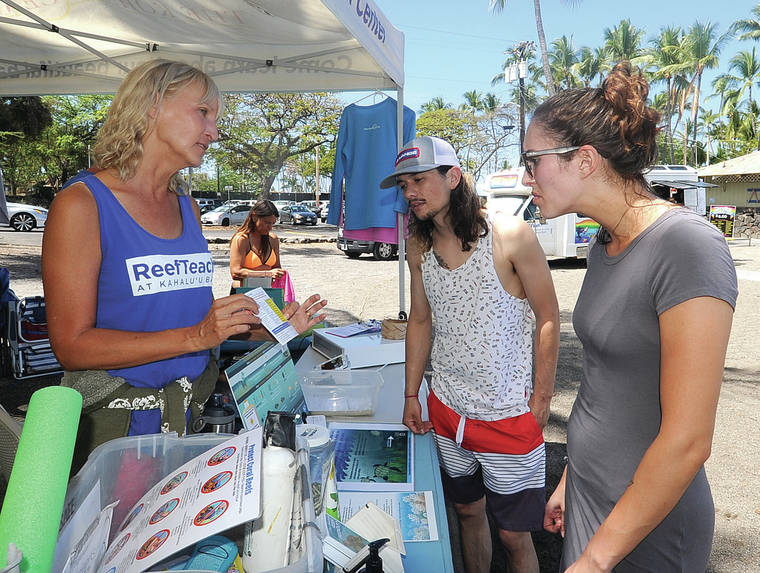Testing finds extremely high oxybenzone levels at Kahaluu Bay

Visitors swim and snorkel at Kahaluu Beach on Wednesday. (Laura Ruminski/West Hawaii Today)

Reef Teach volunteer Susan Menton, left, explains what to look for on a sunscreen ingredient list to Sarah D’Angelo and Anthony Ernst of California Wednesday at Kahalu‘u Beach. (Laura Ruminski/West Hawaii Today)
KAILUA-KONA The Kahaluu Bay Education Center last April commissioned testing to measure bay waters for the presence of oxybenzone, a chemical compound found in sunscreens and known to be harmful to coral ecosystems.
KAILUA-KONA — The Kahaluu Bay Education Center last April commissioned testing to measure bay waters for the presence of oxybenzone, a chemical compound found in sunscreens and known to be harmful to coral ecosystems.
The results returned last weekend were alarming.
ADVERTISING
Oxybenzone was gauged at 2,947 parts per billion at one sample site, and across the bay the chemical’s concentration was found in amounts 262 times greater than levels considered high-risk by the U.S. Environmental Protection Agency.
“That sample there is the highest we’ve ever measured in the world,” said Craig Downs, executive director of Haereticus Environmental Laboratory, which conducted sampling at five different sites in Kahaluu Bay. The National Oceanic and Atmospheric Administration conducted test analysis after results were returned.
Downs conceded numbers were likely higher because that particular sample was taken where most people enter the water on a day characterized by heavy beach traffic. But the testing shows time is of the essence when it comes to sunscreen pollution in West Hawaii, he contended.
“At the rate that we’re seeing Kahaluu die, you’ve got 10 to 15 years before there’s nothing there,” Downs said.
The Legislature passed a bill in 2018 banning in Hawaii sunscreens containing oxybenzone and octinoxate. The law will take effect on the Jan. 1, 2021.
The question of whether that measure is too little, too late comes down to how much reef degradation is assigned to each of its known causes.
Lindsey Kramer, Eyes of the Reef Hawaii Island coordinator, said while the conversation about chemical pollution is a crucial one to have, it can detract from focus on rising ocean temperatures due to climate change. That factor, she said, is inextricably linked to the mass bleaching events that killed roughly half of West Hawaii’s corals just a few years ago.
“I think it’s important to kind of distinguish (a problem like oxybenzone) as a localized threat that we do have a lot of control over, versus climate change threats that are more global,” she said.
Downs described sunscreen pollution as a “contributing factor” to declining reef health in Hawaii, mentioning it alongside erosion and cesspool pollution. However, his take on climate change as it relates to reef health diverges from Kramer’s and many others’ in significant ways.
Marine ecosystems have been impacted by high surface temperatures for hundreds of years but have remained relatively resilient, he said, equating bleaching events at 8- to 16-year intervals to forest fires that allow nature to reset and biodiversity to flourish.
The common denominator in areas where reefs don’t recover is the presence of people, Downs said, as well as the pollution they bring with them. Located just off Alii Drive, upward of a half million people dip into Kahaluu Bay every year.
“In places where there aren’t people … where there was massive coral bleaching and the reefs died, five years later the reefs were coming back and the biodiversity increased,” Downs said of areas like the Maldives and the Cook Islands.
Widespread bleaching events and coral recovery rates throughout Hawaii for three consecutive years in the middle of the decade appear to indicate with little ambiguity that high ocean temperatures remain the underlying cause and greatest threat to reef health. Still, experts and stakeholders across the board agree new regulations on the $9 billion sunscreen industry are as needed as they are overdue.
“Unlike climate change, we can control this. I think it’s an opportunity for us to involve our visitors and to educate because that’s what we do,” said Cindi Punihaole, Director of the Kahaluu Bay Education Center. “It’s not a difficult step. It’s just a choice. Protect and heal the bay. It would be a benefit not just to our environment, but to future generations.”
Harmful chemicals in sunscreens don’t end up in the ocean solely because of people swimming. They also find their way into nearshore waters by way of gray wastewater from showers and the like.
Oxybenzone, octinoxate and potentially other ingredients in sunscreen that still require more study can deform coral larvae and damage coral DNA, decrease fish fertility and populations, and negatively impact green algae by stunting its growth and disrupting photosynthesis, according to NOAA. They’ve also been linked to negative impacts on sea urchin, mussels and dolphins.
Sunscreens considered to be reef safe are mineral-based sun blockers that utilize either titanium oxide or zinc oxide as an active ingredient. Kramer warned, however, there are several brands of sunscreen that claim on the packaging to be reef safe but are not.
“It’s so important for consumers to read labels and keep up to date with the latest research,” she said.


